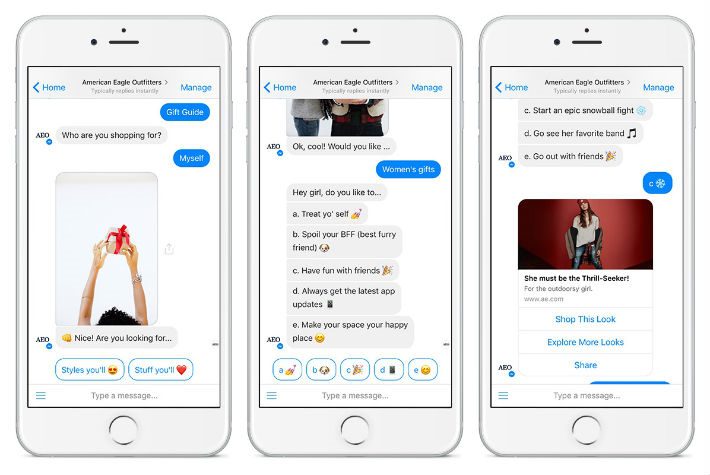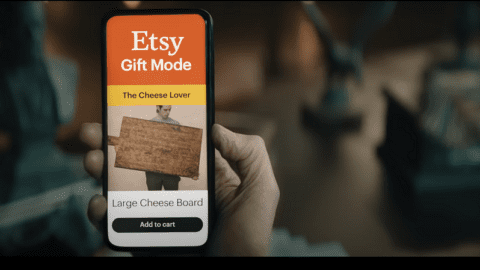If 2016 was the year chatbots entered the retail scene, then 2017 will be the year brands will start to realize real business results from the technology, through increased sales, conversion rates or customer loyalty. When deploying chatbots as part of an overall business strategy, retailers should consider the following three points:
-
Chatbot experiences must be consistent across all channels;
-
Advanced customer data analysis is necessary to build contextual conversations; and
-
Human representatives remain a vital component of the customer service process and are still needed to communicate with consumers effectively.
Advertisement
Nordstrom, 1-800-Flowers, American Eagle Outfitters and Sephora are just a few of the biggest brands that implemented artificial intelligence-powered chatbot technology in 2016, launching intelligent assistance tools on messaging platforms such as Facebook Messenger and Kik. These retailers already have leveraged consumer data with the chatbot technology to perform a wide range of tasks, including:
-
Launching holiday gift guides;
-
Providing product recommendations;
-
Serving as customer concierges;
-
Assisting the in-store shopping experience;
-
Processing orders; and
-
Sending shipping information updates.
Yet many industry experts believe chatbots could become even more closely integrated into the shopper journey, particularly as consumers become more accustomed to the technology’s possibilities.
“Today, people just think about using their mobile devices to research straightforward facts like the number of people who live in Ohio,” said Kurt Heinemann, CMO of Reflektion. “However, in the future, you could just ask Siri or Google Now to help you find a large black blouse from Banana Republic. Then with just a few clicks you could order the right blouse via Apple Pay — which will already have your shipping preferences stored — without ever having to visit the Banana Republic web site itself. Chatbots, combined with individualized product recommendations, will result in more ‘intelligent engagement’ with shoppers.”
But despite the opportunity to use chatbots to conduct personalized interactions with consumers, only 2% of brands have a chatbot on Facebook Messenger and just 1% have implemented a chat bot on Kik, according to L2’s upcoming Intelligence Report: Social Platforms 2017. So while the rate of adoption is still nascent, more companies should consider the benefits of a chatbot implementation.
“Imagine that you had a chatbot when you walk into a store like Home Depot,” Heinemann said. “Your ‘virtual assistant,’ via the chatbot could answer: Where are the door hinges? Where are the door knobs? Or imagine that you’ll be able to go into a department store and just type into your phone, ‘women’s blouses in black’ and be mapped automatically to items based on your previous preferences and locally available inventory.”
Cross-Channel Consistency Is Key
When planning a chatbot implementation, the first priority should be to create a consistent experience across all channels. Since just 22% of U.S. consumers are familiar with chatbots, retailers must streamline the technology so new users can easily engage through their channel of choice. As mobile shopping continues its massive growth, brands need to focus on optimizing chatbots within their e-Commerce sites, third party messaging platforms and their own mobile apps.
“The reality is, as an enterprise or a major retailer, you have to make sure all your digital touch points are good, and that one isn’t far better than the others,” said Daniel Hong, Senior Director of Product Marketing Strategy at [24]7. “The whole message of chatbots is lost when you just direct a consumer to Facebook Messenger or WhatsApp and don’t bother with your own mobile app. If you’re a CEO, you’re not going to neglect your own web site, you have to make that powerful as well.”
Data Drives Contextual Conversations
Brands also should leverage consumer data to understand when and where a chatbot can best engage shoppers. By analyzing prior shopper interactions, length of log-in times and time on specific pages, retailers can gauge when shoppers may be most interested in a chat.
Gathering this consumer data is vital for contextual, conversational messaging, but fine-tuning and adapting it to every customer interaction is even more critical to creating a relevant chatbot experience. Retailers can now create an accurate representation of the customer for a personalized one-on-one interaction using this machine learning technology.
“In the past, chatbots were kind of dumb,” Hong said in an interview with Retail TouchPoints. To avoid having the bot seem intrusive or unnecessary, retailers need to use dynamic data and multiple factors to introduce it to the right person, at the right time.
“If you’re going through a web site and a bot interjects, asking if you need help, how is that triggered?,” Hong added. “Is it based off your clickstream journey? Is it based off your customer profile, and are there are lot of other different data signals that are being leveraged in real time that can proactively engage you?”
Human Interaction Minimizes Shopper Resistance To Chatbots
To become a go-to technology for consumers, chatbots must prove their relevance and ability to improve the shopping experience. As many as 73% of shoppers said they would likely not use a company’s chatbot again after a bad experience, according to a DigitasLBi poll. Additionally, chatbots should not feel like a machine to shoppers. As many as 60% of consumers said they knew they were communicating with a chatbot because the interaction was robotic and the responses felt artificial.
Many consumers still prefer real human interaction as part of their shopping experience, therefore retailers must position the chatbot experience as an added customer service asset rather than a potential replacement. This means retailers must provide the option to switch to a live representative during a customer service call, especially as the conversation becomes more complex.
“2016 brought us the popularity of chatbots, but brands will learn in 2017 that chatbot interactions can only hold a meaningful customer conversation for so long,” said Peter Friedman, Chairman and CEO at social customer experience company LiveWorld. “Humans are still needed to communicate with customers. Seamless chatbot and human integration is the combination that will advance the customer experience for brands.”
Through 2017 And Beyond
Friedman noted that the success of chatbots can ultimately have a long-term effect on e-Commerce interactions moving forward: “While web sites won’t become obsolete in a year, retailers will be capturing human behavior in commerce, which means a stronger focus on messaging apps and the beginning of the end for web sites.”
As chatbots gain mainstream appeal, brands should make sure they’re providing customers with convenient and valuable information rather than just pushing more marketing messages in a new channel, added Amit Sharma, CEO of Narvar.
“In 2017, brands will create curated experiences based on customers’ preferences and past purchases, such as knowing whether they prefer sparkly or classic holiday sweaters,” said Sharma in an interview with Retail TouchPoints. “This is data which companies like StitchFix and Trunk Club already leverage in other ways — the magic will be applying it to conversational commerce. This data knowledge will be applied to payment and shipping options next. If a customer always chooses the same credit card and two-day delivery, retailers should remember and auto-populate that information for future purchases.”









